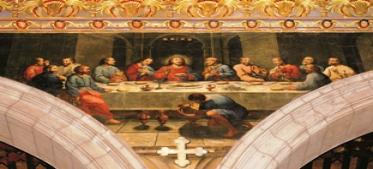Do you know what was served at the Last Supper? The answer is not exactly straight forward.
If you refer to Michelangelo's famous painting you will see there is nothing on the plate directly in front of Jesus. If you read the Gospels you will find that only wine and bread are specifically mentioned, while Mark and Luke refer to a Passover lamb.
And if you find yourself in Quito, the Cathedral Church offers a different menu. An image of the Last Supper, painted by Manuel Samaniego, depicts guinea pig as the main course. The wine has been replaced with a corn-based drink called chicha and the bread is of a special kind – a type of cornbread known as humita.
The insertion of these regional food choices into the painting of the Last Supper is an example of syncretism, a practice of blending the influences of two cultures, in this case, the Spanish Catholic tradition and indigenous Andean civilization.
Syncretism can be applied to expressions of a culture, including art, religion, and architecture. It is a way of reconciling disparate practices or beliefs – unifying them for broader acceptance.
The presence of guinea pig, humitas, and chicha at the Last Supper shows the extent to which these foods are more than just traditional staples in Ecuador, they are culturally symbolic. And if they are important enough to be inserted into one of the most famous scenes of Western Civilization, then we should give them a try.
CUY
Guinea pig, or "cuy" as it is known, derives from the Quecua word, "quwi." It has been a staple in the Andean region since before the Spanish introduced other meat sources of protein, such as pig, cattle, and sheep.
Guinea pigs are often sold for about $8 by their producers, and a full cuy meal at a typical restaurant will run from $12-24. They are often roasted, but can also be baked or fried. Cuy is commonly served with potatoes, avocado, or other traditional foods such as hominy (mote).
Though a traditional preparation is to offer whole cuy, with head and toes included, La Gloria Restaurant in Quito serves a visually more appetizing version: "Piernitas de cuy crocante," or crunchy guinea pig legs. Here is their recipe:
La Gloria's Crunchy Guinea Pig Confit with creole peanut sauce and golden, rustic potatoes
Ingredients
4 Guinea pig legs
4 potatoes
1 tbsp. Onion
Pretzel salt
Vegetable oil, as needed
Peanut sauce ingredients
Salt and pepper, as desired
100 gr. Crushed peanuts
30 gr. Aji Panca
20 gr. Aji Mirasol
1 tbsp peeled garlic
Chicken broth
Preparation
Candy the guinea pig legs with red pepper and pretzel salt for 40 minutes at 80 degrees Celsius.
Fry in abundant vegetable oil until golden brown and crunchy. Remove and apply additional salt as desired.
Sauce preparation
Make a dressing with onion, garlic, ajis. Incorporate chicken broth, then add crushed peanuts. Mix well.
Serve accompanied with golden potatoes.
HUMITAS
A pre-Hispanic food similar to a tamale, humitas are corn based breads, steamed and wrapped in the same corn husk from which their primary ingrediant comes.
Humitas are typically prepared with unripened corn (maiz tierno) from which a corn flour is made and mixed with butter, cheese, eggs, and sometimes other spices. Variations on the recipe exist, as you can find humitas with chicken or even sweet-tasting humitas. They are typically served with coffee for breakfast or offered as an afternoon or evening snack.
Today's is by chef Mauricio Armendaris, published in his book Mishki Mikuna.
Corn Humitas
Ingredients
1 ½ lbs Threshed corn, mature from the cob (“cao”)
½ cup Butter
¾ cup Fressh grated cheese
2 tbsps Salt
1tsp Sugar
6 egg yolks
1tsp Baking powder
1tbsp Julienne cut white onion
½ cup egg whites
Corn husks
Preparation
Mix corn kernels in the grinder or food processor and sift to eliminate all of the husk.
Cream the butter with cheese, salt, and sugar.
Add yolks one at a time
Add to the sifted corn mix, baking powder and onion
Beat egg whites until white and add to the dough
Place ½ cup of dough on each corn leaf and close well
Steam for an hour until firm.
CHICHA
Chicha is a tradtional drink derived from the fermentation of corn or other grains. It can be prepared as an alcoholic or non-alcoholic beverage. It dates back to Incan cultures, as chicha traditions were found throughout the Incan Empire.
Typically, chicha in Ecuador is prepared from corn, rice, oatmeal, quinoa, or barley. Other ingredients, such as local fruits, sugar, and even herbs are often added to give it flavor as it ferments over a period of three days, on average.
Today's recipe is from Chef Pablo Zambrano of the Hotel Colon and published in his book 111 Platos Populares del Ecuador.
Chicha de Jora
Ingredients
250 gr. Corn flower
2 ½ liters wáter
150 gr. Pineapple
150 gr. Naranjilla
2 sticks lemon verbena (hierbaluisa)
2 cloves
1 orange peel
500 gr. Panela (unrefined whole cane sugar)
1 stick cedron
1 anise, crushed
Cinnamon
Preparation
Boil water with lemon verbena, cloves, orange peel, cinnamon, panela, cedron, and anise. Add corn flower dissolved in cold water. Boil for 45 minutes and strain. Place in ceramic bowl and let sit for three days. Cook the naranjilla in water. Liquify with reserved liquid. Strain and add previous preparation. Peel and cut pineapple. Liquify with the same preparation. Strain and add again. Mix well. Adjust sweetness.
Recommendation: Store the chichi in a fresh place without a lid during the three day fermenting period. The pot should be cured and clean.
Ciudad Quito
